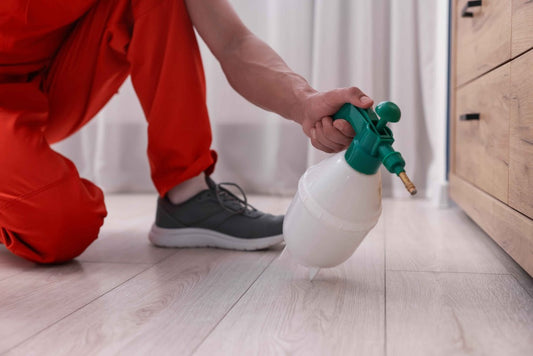
How to Get a Mouse Out of Your Car (Step-by-Step Guide)
Share
Don’t be fooled by their size — mice in your vehicle’s engine is a big problem.
And knowing how to get a mouse out of your car can feel like no small feat.
Every year, vehicle owners spend millions in rodent-related repairs, from chewed wiring to contaminated air filters. A single mouse can put your car in the shop in a matter of days. Acting quickly can save your car and your wallet.
This guide walks you through exactly how to get rid of a mouse in your car — and how to keep it from happening again.
TL;DR: How to Get a Mouse Out of Your Car
- Open your hood to expose the engine bay
- Scare the mouse off using sound, heat, and light
- Use repellents like peppermint oil or Irish Spring soap
- Place traps inside and around the vehicle
- Call pest control if needed
- Deep clean your car to remove scent trails and health hazards
- Seal up entry points in your garage and vehicle
- Install a Box-Kat barrier to prevent future infestations
8 Steps to Getting a Mouse Out of Your Car
1) Open Your Hood
Exposing your car to the elements might sound like an open invitation for rodents, but the opposite is actually true. The comfort of an enclosed engine bay provides safety. Colder temperatures, light, and noise can make your car feel a less like the Ritz and more like a Motel 6.
2) Try to Scare the Mice Off
If the mouse has yet to build a nest or start stashing food, there’s a chance you might be able to scare it off before it settles in.
Try the following:
- Crank up the heat: While mice might enjoy the warm comforts of your vehicle’s interior, they aren’t a fan of extreme heat. Find a sunny place to park your car, roll up the windows, run your heater, and see if you can’t convince those pesky invaders to leave on their own.
- Make a lot of noise: Mice like their peace and quiet. Honking your horn a few times might just be enough to frighten them off. You can also try blasting loud music, tapping the sides of your car, or investing in an ultrasonic deterrent.
- Turn on the light: Rodents are nocturnal. If your car is stored in a garage, keep the lights running overnight to make the area less comfortable. Placing LEDs underneath your vehicle or in the engine bay can also be an effective option.
- Drive your car: If you want to create a fully well-rounded disturbance, take your car for a spin. Stationary vehicles are prime targets for mice.
3) Use Rodent Repellents
For as stubborn as they are, mice are actually quite sensitive. Rodent repellent sprays may not be foolproof solutions, but they can play a complementary role to your rodent-proofing strategy.
- Peppermint oil: The strong menthol scent is irritating to a mouse’s sensitive nose. Spray under the hood, around wheel wells, floorboards, and any other entry points. You can also soak cotton balls directly in the oil and place in air vents and glove compartments.
- Pros: It’s not an unpleasant smell and it’s non-toxic.
- Cons: Needs frequent reapplication to work properly.
- Dryer sheets: Mice also hate the smell of scented dryer sheets. Tuck them under seats, in the glove box, trunk, and under the hood.
- Pros: Cheap and easy to find.
- Cons: The scent can fade very quickly
- Irish Spring soap: Another smell that mice hate, Irish Spring soap is a simple deterrent. You can slice it up into tiny chunks and place around your car.
- Pros: The scent will last longer than other options.
- Cons: Can leave residue if it melts. Some rats will still chew on it.

4) Place Traps Around the Vehicle
If your rodent problem remains, you may be forced to use traps. We recommend simple snap traps as the easiest and most effective option. They offer a quick and humane kill with easy disposal.
Live catch traps are a more humane option, but they may only delay the infestation if the mice aren’t released far enough away. Conversely, glue traps are the least humane option and largely unnecessary.
And always make sure to take proper safety precautions when disposing of dead mice to avoid disease.
For tips on where to set your traps, check out our full guide on Where to Put Mouse Traps for Best Results.
Mouse Trap Setup Tips:
- Use multiple traps at once: Mice are suspicious creatures. Several traps increase the odds of the catch.
- Anchor the traps: Use painter’s tape or some other adhesive to keep the trap from moving when triggered.
- Surround the trap: Place the trap so that the bait can’t be easily accessed from the side. A tissue or shoe box works great.
- Use gloves: Avoid transferring human scent onto the traps.
- Combine with repellents: The one-two punch will drive mice away from the vehicle and into the trap.
5) Call a Pest Professional
If you can’t get the mice out of the car on your own, it may be time to call in the professionals. While many preventative measures can be handled on your own, none of them will matter if there is currently a mouse in your car.

6) Clean Everything
Once you get rid of the mice, deep cleaning the area is essential. Not only must you remove the smells and droppings, but it’s important to eliminate health hazards and erase scent trails that could attract more rodents.
Mice can carry bacteria, viruses, and parasites that can pose a serious health risk to humans — like the deadly hantavirus. While cleaning, never forget to wear gloves and a mask, as dangerous debris can become airborne.
- Remove all visible debris: Start with the obvious. Dispose of nesting materials (shredded paper, insulation, etc.), food stashes, and trash.
- Vacuum the interior: Use a strong vacuum that allows you to get into cracks and under seats.
- Disinfect surfaces: Choose an antibacterial cleaner and allow the solution to sit for five minutes before wiping.
- Treat soft surfaces: For cloth seats and carpets, use a fabric-safe disinfectant spray. A simple wipe should work for leather and vinyl seats.
- Replace the air filters: Mice are known for nesting in air filters. This is particularly dangerous as bacteria can be blown out through your A/C and heater.
7) Seal All Entry Points
The next (and very important step) is to keep the mice from returning by sealing all entry points. Mice can squeeze through holes as small as ¼ inch (about the size of a pencil). That means even the tiniest gaps can serve as an entryway. And because mice are also excellent climbers, that means you have to be aware of cracks and holes throughout your garage or storage area.
Inspect the area and use any of the following tools to seal entry points:
- Steel wool
- Expanding foam sealant
- Silicone caulk
- Garage door seals
- Door sweeps

8) Install a Box-Kat Mouse Barrier
The best way to deal with a mouse problem is to prevent it from happening in the first place.
The Box-Kat mouse barrier is your car’s ultimate defense against rodents. Its patented design ensures that mice can’t jump over or burrow under.. Whether you’re safeguarding your personal car, trailer, RV, or van, Box-Kat offers peace of mind and long-term protection.
Invest in a Box-Kat today and keep your car ready for the road — not the repair shop.
Frequently Asked Questions
Will a mouse leave my car on its own?
It’s possible — but unlikely. If a mouse has already built a nest or found a food source inside your car, it’s probably planning to stay. That’s why it’s important to take active steps to make your car uncomfortable and remove any attractants as quickly as possible.
Can I still drive my car if there’s a mouse inside?
Technically, yes — but it’s not recommended. Mice can chew through critical wires, nest in air filters, or get caught in moving parts, creating both health and mechanical risks. If you suspect a mouse is inside, remove it before operating the vehicle whenever possible.
What’s the best bait for a mouse trap in a car?
Peanut butter is a classic — its strong scent and sticky texture make it hard for mice to resist or steal. You can also try chocolate, dried fruit, or small bits of granola. Just make sure to replace bait regularly and handle it with gloves to avoid human scent transfer.
How long can a mouse survive inside a car?
Mice are highly adaptable. As long as they have shelter and access to food (even crumbs), they can survive for weeks or even months inside a vehicle. That’s why even a short-term infestation can lead to major damage if not dealt with quickly.
What attracts mice to cars in the first place?
Warmth, shelter, and access to food. Vehicles that are stored for long periods — especially in garages or near wooded areas — are prime targets. Insulation, upholstery, and leftover food all make ideal nesting materials or snacks.



